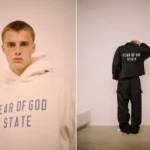When you talk about modern streetwear, especially in London’s cultural landscape, there is one brand that sits at the intersection of authenticity, rebellion, music, and underground culture: Trapstar UK. More than just a clothing line, Trapstar is a movement — a living embodiment of London’s street identity — shaped by the voices, experiences, and codes of a city that never stops reinventing itself. Founded by three friends in West London, the brand didn’t rise through traditional fashion channels or high-profile runways. Instead, it came from pop-ups in estates, word-of-mouth exclusivity, artists championing the label long before it had mainstream presence, and a devotion to secrecy that made the brand feel like an exclusive urban passport.
Today, trapstar is a global force — worn by celebrities, studied within the fashion industry, and still embraced by the same streets that birthed it. But understanding how it arrived here means looking far beyond hoodies, coach jackets, and gothic fonts. Trapstar is cultural storytelling stitched into fabric.
Underground Origins: A Brand Born from the Real London
Trapstar’s story begins in the neighborhoods of West London, where creativity and street realities lived side by side. Unlike the polished branding strategies of heritage fashion houses, Trapstar emerged organically — built by individuals who lived the lifestyle before they ever branded it. The founders created apparel for their circle first: pieces made not to impress investors but to represent identity and loyalty.
Instead of mass stores, there were trunk-drop deliveries — clothing passed through private networks and closed circles. This wasn’t scarcity for marketing’s sake; it was scarcity born from authenticity. You had to belong to understand. And that is what made early Trapstar wearers feel chosen.
This was the birth of Trapstar’s most defining characteristic: mystique. Before luxury brands discovered “exclusivity,” Trapstar had already turned it into culture.
The Trapstar Name: A Reflection of Duality
The name “Trapstar” itself tells a story. It reflects two worlds: the trap — survival, hustle, grit — and star — ambition, self-belief, glow-up energy. That duality is what resonated deeply with urban youth. It didn’t ask them to become something new — it told them their story was already worthy of spotlight.
The brand wasn’t selling aspiration. It was selling recognition.
Trapstar didn’t tell young people to leave the streets to become somebody — it said you can come from the streets and already BE somebody. That shift in psychology is one of the most underestimated reasons behind its cult-level following.
Music: The Catalyst That Carried the Brand Global
While Trapstar began as a quiet force in London, it didn’t remain underground for long. It moved with culture — and culture, especially London culture, moves with music.
Grime, drill, UK rap, and later American hip-hop artists embraced Trapstar not as a sponsorship but as a reflection of their own identity. Artists like Rihanna, Stormzy, A$AP Rocky, and Jay-Z all wore Trapstar long before big retailers stocked it. Jay-Z’s later involvement through Roc Nation only validated what the streets already knew — that Trapstar had arrived and wasn’t going anywhere.
For Trapstar, celebrity co-signs were not brand deals — they were cultural alignment. The brand did not chase stars; the stars came to Trapstar because it already carried weight.
Aesthetic DNA: Darkness, Rebellion, and Urban Royalty
In terms of design, Trapstar fuses high-impact visuals with storytelling. Its pieces often pull from:
-
Gothic fonts and rebellious typography
-
Camouflage and utilitarian silhouettes
-
Apocalyptic tones mixed with luxury finishes
-
Visual codes — like the “T” logo mask — that speak to those in the know
The hoodies, jackets, and tracksuits are not just garments — they are signals. Wearing Trapstar is a declaration: I am part of something bigger than fashion. The brand’s use of menace, rebellion, and street poetry is not decorative — it is autobiographical.
Community Before Commerce: Why the Loyalty Runs Deep
Trapstar never tried to sell to everyone. It spoke to those who lived the culture first. That approach created community cohesion before commercial expansion. People were not just customers; they were participants.
This authenticity also changed how other brands approached streetwear. Where once streetwear was seen as a trend or subgenre, Trapstar helped transform it into mainstream cultural currency. To understand how significant that is — consider that fashion giants now study streetwear to stay culturally relevant. Trapstar didn’t adapt to high fashion. High fashion had to adapt to Trapstar.
London Representation: Wearing the City Like Armor
Trapstar is unapologetically London. Not the glossy postcard version — but the lived one. The buses, the tower blocks, the slang, the Tube station energy, the cold mornings, the sirens, the corners where ideas grow as quickly as reputations.
The brand is both armor and identity. For many Londoners, Trapstar is wearable testimony — proof that stories born in the underground can rise without compromise.
How Trapstar Changed Urban Fashion
Trapstar didn’t just succeed — it shifted the industry. Here’s how:
| Innovation | Cultural Effect |
|---|---|
| Grassroots exclusivity | Made ownership feel like membership |
| Music co-signs rooted in authenticity | Turned clothing into cultural storytelling |
| London identity | Put UK streetwear on the global map |
| Rebellion-based branding | Allowed streetwear to challenge luxury, not mimic it |
| Community-first growth | Built loyalty stronger than marketing could |
The brand forced mainstream fashion to respect street narrative instead of merely borrowing from it. It blurred the line between underground and luxury — proving they could coexist in a single garment.
The Trapstar Philosophy: Fashion as Reflection, Not Performance
Trapstar refuses to act like a brand performing toughness. It is the environment it comes from — so there’s no costume, no persona, no exaggeration. This difference is why consumers don’t feel like they’re buying a look — they’re buying alignment.
In an age where authenticity is the most valuable currency, Trapstar has something most brands cannot imitate: origin story as proof of legitimacy.
The Global Stage — and Still Rooted in the Streets
Trapstar now operates internationally, appearing in major drops and limited releases that sell out instantly. And despite global reach, it has retained its street loyalty. It hasn’t been diluted by fame — instead, it has become a blueprint for other grassroots fashion movements.
Where most brands “scale up,” Trapstar “scales inward,” deepening connection, not just widening audience.
Conclusion: The Brand That Didn’t Just Enter Fashion — It Reshaped It
Trapstar UK https://trapstarofficialshop.com/ is more than a clothing line — it is a cultural monument built from grit, ambition, and real London identity. It democratized streetwear without sanitizing it. It created fashion credibility without seeking validation from traditional institutions. It proved the streets don’t need fashion’s permission to define what style means.
Most importantly, Trapstar is not a trend — it is testimony. A reminder that culture doesn’t become powerful when the world discovers it. It becomes powerful when the streets protect it long before the world even knows it exists


